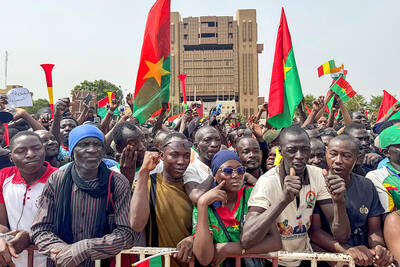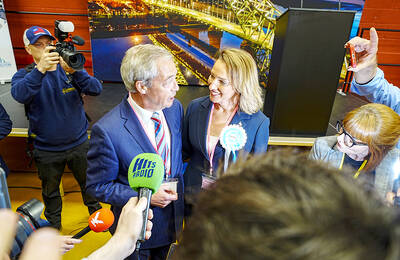For Tashi Choezom, a Tibetan studying for a nursing degree in New Delhi, the string of suicides by Tibetan monks who have set themselves on fire to protest Chinese religious repression are a sin.
“I express my solidarity with those who have committed self-immolation, but it is terribly wrong to take one’s own life,” Choezom said at a recent demonstration by exiled Tibetans.
Yesterday, a Tibetan nun burnt herself to death in southwest China, Xinhua reported, becoming the 11th Tibetan this year known to have set themselves on fire.
Qiu Xiang, 35, set herself on fire at a road crossing in Sichuan Province, Xinhua said, citing the local government.
The nine Buddhist monks and two nuns who have set themselves ablaze this year — chanting for religious freedom and the return of the Dalai Lama to his homeland — have brought international attention once more to the Tibetan campaign.
“We are getting support from various countries through this, but these acts of self-immolation must stop. Buddhism does not allow this,” said Choezom, who has never been to Tibet.
The protests began in March when a 21-year-old monk called Phuntsog set himself on fire at the influential Kirti monastery in Si-chuan, which borders Tibet and has a large Tibetan population. At least another six have died since then, and their actions mark a new phase in resistance to Chinese rule.
However, they have also divided opinion in the exile community: Some feel the ends justify the means, others are staunchly opposed to suicide or attempted suicide on religious grounds.
A culture of self-censorship because of heavy Chinese security and restrictions placed on reporters in the remote Himalayan province make measuring opinion inside Tibet extremely difficult.
Geshey Lobsang, a monk at the monastery of the Dalai Lama in Dharamsala, the Tibetan spiritual leader’s home-in-exile in India, said when it comes to suicide the teachings of Buddhism are ambiguous.
“It is sin to destroy one’s body, but Buddhist philosophy also states that every action should be driven by good motivation and reason,” he said. “So, if the Tibetans self-immolated with a good motivation and to fulfill a higher cause, it cannot be counted as sin.”
The spate of self-immolations has also posed a dilemma to the government-in-exile, which cannot be seen to encourage a protest movement that costs lives.
The prime minister of the Tibetan government--in-exile, Lobsang Sangay, has paid tribute to the “courage” of the protesters and held a day of prayers in solidarity.
“The real question is why are these young Tibetans doing this?” said Samphel Thubten, a spokesman for the government-in-exile.
“Their actions grow out of really repressive measures put in place and the fact that the victims of that repression have nowhere to turn,” he said.
While views on whether suicide is a legitimate form of protest vary among exiles, the diagnosis of why monks are taking their own lives is unanimous.
“I’m personally against this way of protest. In Buddhism, it’s a big sin. But they don’t have a choice because they are not allowed to practice their faith,” said Tsewang Dolma, a 28-year-old Tibetan refugee in Kathmandu, Nepal.
Others echo the widely held belief that the self-immolations are a cry of desperation from a people who fear that their religious identity and culture are losing a battle for a survival.
Many Tibetans feel the region is being “colonized” by ethnic Chinese Han and fear for the future of their language and customs.
In 2008, riots broke out in the capital Lhasa, other areas of Tibet and neighboring Chinese provinces with Tibetan populations. Chinese Han and Muslim Hui and their businesses were targeted in unrest.
At the Kirti monastery, the focal point of the recent troubles, Kate Saunders from the International Campaign for Tibet said religious ceremonies have been halted there since March, with even the burning of incense prohibited.
“For some of the monks, their religious identity is more important than life itself,” she said.
The Dalai Lama, who Tibetans look to for guidance on religious and political developments, is yet to comment on the self-immolations, although he did take part in public solidarity prayers.
The spiritual leader, who fled to India in 1959 after a failed uprising against Chinese rule, has held nine rounds of fruitless talks through his envoys with Beijing about the status of his Himalayan homeland.
“We follow His Holiness’ path of peace and non-violence, but now we have no choice left,” said 30-year-old Kyenrab Nawa, who works at a Tibetan cultural center in New Delhi.
“These supreme sacrifices do not mean we are veering away from our way of life,” Nawa said.

Kehinde Sanni spends his days smoothing out dents and repainting scratched bumpers in a modest autobody shop in Lagos. He has never left Nigeria, yet he speaks glowingly of Burkina Faso military leader Ibrahim Traore. “Nigeria needs someone like Ibrahim Traore of Burkina Faso. He is doing well for his country,” Sanni said. His admiration is shaped by a steady stream of viral videos, memes and social media posts — many misleading or outright false — portraying Traore as a fearless reformer who defied Western powers and reclaimed his country’s dignity. The Burkinabe strongman swept into power following a coup in September 2022

‘FRAGMENTING’: British politics have for a long time been dominated by the Labor Party and the Tories, but polls suggest that Reform now poses a significant challenge Hard-right upstarts Reform UK snatched a parliamentary seat from British Prime Minister Keir Starmer’s Labor Party yesterday in local elections that dealt a blow to the UK’s two establishment parties. Reform, led by anti-immigrant firebrand Nigel Farage, won the by-election in Runcorn and Helsby in northwest England by just six votes, as it picked up gains in other localities, including one mayoralty. The group’s strong showing continues momentum it built up at last year’s general election and appears to confirm a trend that the UK is entering an era of multi-party politics. “For the movement, for the party it’s a very, very big

ENTERTAINMENT: Rio officials have a history of organizing massive concerts on Copacabana Beach, with Madonna’s show drawing about 1.6 million fans last year Lady Gaga on Saturday night gave a free concert in front of 2 million fans who poured onto Copacabana Beach in Rio de Janeiro for the biggest show of her career. “Tonight, we’re making history... Thank you for making history with me,” Lady Gaga told a screaming crowd. The Mother Monster, as she is known, started the show at about 10:10pm local time with her 2011 song Bloody Mary. Cries of joy rose from the tightly packed fans who sang and danced shoulder-to-shoulder on the vast stretch of sand. Concert organizers said 2.1 million people attended the show. Lady Gaga

SUPPORT: The Australian prime minister promised to back Kyiv against Russia’s invasion, saying: ‘That’s my government’s position. It was yesterday. It still is’ Left-leaning Australian Prime Minister Anthony Albanese yesterday basked in his landslide election win, promising a “disciplined, orderly” government to confront cost-of-living pain and tariff turmoil. People clapped as the 62-year-old and his fiancee, Jodie Haydon, who visited his old inner Sydney haunt, Cafe Italia, surrounded by a crowd of jostling photographers and journalists. Albanese’s Labor Party is on course to win at least 83 seats in the 150-member parliament, partial results showed. Opposition leader Peter Dutton’s conservative Liberal-National coalition had just 38 seats, and other parties 12. Another 17 seats were still in doubt. “We will be a disciplined, orderly